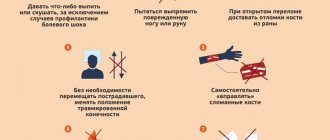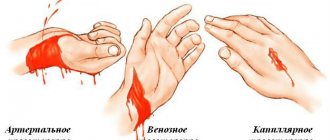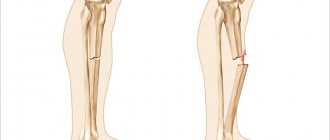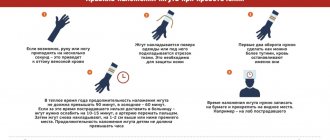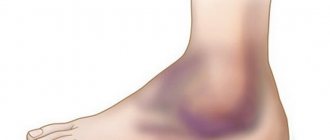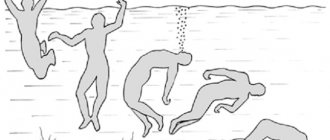Action recommendations for bites of midges and mosquitoes
The prevalence of midges throughout the globe is so wide that this type of insect does not live only in Antarctica. That's why so many people are attacked by them every day. It would seem that what harm could a millimeter-sized insect do to a massive person. But the whole difficulty lies in the toxicity of their saliva in relation to the tissues of the human body. Each subspecies of midges has different toxicity, causing various pathological abnormalities.
The general scientific name for the body's reactions to midge bites is called simulidotoxicosis.
The manifestations of a midge attack are not long in coming. Although in some situations a person may not even understand what happened to him, without seeing or feeling what he was exposed to. This is due to the exceptional aggressiveness of most midge representatives. They attack so quickly that the skin receptors do not have time to register the irritation. When it comes into contact with the surface of the skin, the midge instantly gnaws off part of its surface layers, lubricating the wound surface with saliva (the main difference from mosquitoes). It, acting as an anesthetic, allows the insect to remain unnoticed for a certain time. If the moment of the bite was not felt, the midge sucks blood and lymph from the wound surface, which is necessary for its life cycle and reproduction of offspring.
Allergy to a bite is based on the contents of the insect's salivary glands, which are represented by hemolyzing and allergenic substances. There is a pattern - the more painful the bite, the stronger the reaction to it. It consists of manifestations that are very clearly displayed in the table.
| Symptoms | Manifestations |
| Local changes |
|
| General reactions |
|
The severity of the allergy depends on several factors:
- Type of midges and number of bites
- The immune status of the body and the age of the person
- Tendency to allergic reactions
- Individual intolerance to components of midge saliva
- Infection of bite wounds when scratching them
The degree of these conditions or their combination determines the clinical manifestations, duration and symptoms of bites, as well as their outcomes. The most critical manifestation may be the development of anaphylactic shock, which requires immediate resuscitation measures. But fortunately, this is rare.
Itching from a midge bite
Itching is the most common complaint of most people. The itching is very persistent and forces you to scratch the affected areas, which further aggravates the skin condition. But a pattern has been recorded - the greater the itching and local manifestations, the less the degree of general toxic reactions. The body thus limits the process only to the location of the source of intoxication.
Itching itself, as a defensive reaction, is twofold. On the one hand, it signals danger, on the other, it becomes the cause of further changes. Therefore, this symptom can rightfully be called central in the development of local changes in midge bites. This is all due to the fact that people constantly scratch the bite sites, introducing pathogenic pyogenic microorganisms into the thickness of the damaged skin. This causes the progression of local changes in the soft tissues, their suppuration and the long course of the wound process.
How to relieve swelling from a midge bite?
Swelling of the skin in the bite area is another of the main symptoms of multiple midge bites. It is worth noting that it is persistent, bringing discomfort along with itching for a long time. The causes of swelling are a massive release of substances that cause inflammation in the soft tissues. Sometimes it is so extensive and pronounced that it spreads to areas distant from the bite (head, neck, face). Such manifestations are eliminated using the methods given in the table.
| Type of edema | Necessary activities |
| Local swelling |
|
| General swelling |
|
The scope of measures aimed at reducing swelling depends on the intensity and rate of its increase. In most cases, you have to deal with local swelling, which can be easily eliminated under the influence of the given local measures. But in the case of a lightning-fast increase in the type of anaphylactic allergic reaction with spread to the neck and respiratory organs, an immediate threat to human life arises. The response must be immediate. Such patients are provided with free access to air and transported to the nearest medical facility as quickly as possible. Fortunately, this rarely happens with midge bites.
What to do to treat a midge bite?
Very often, multiple midge bites become a real problem not only in terms of unpleasant symptoms, but also in resistance to eliminating them. In most cases, bite marks bother patients for a long time (2-3 weeks). This is especially true if you do not take any measures in this regard or limit yourself to only some of the necessary ones. The approach should be comprehensive, aimed at blocking all links in the pathogenesis of the disease. This is the only way to prevent possible complications.
In a typical course of a wound process following a midge bite, the sequence of changes looks like this: bite – rashes – itching – scratching – skin infection – formation of a wound with inflammation of the surrounding skin. The same clear sequence of measures should be connected to the treatment process, corresponding to pathological changes. The scope of necessary actions, depending on the stages of the process, is presented in table form.
| Type of changes | Scope of events |
| Bite at the time of receipt, accompanied by pain and burning |
|
| Rash that occurs a few minutes or hours after receiving the bite. |
|
| Itching that accompanies bites at all stages of the wound process |
|
| Scratching represented by the superficial layers of the dermis |
|
| Skin infection with wound formation |
|
| Covering wounds with black scab |
|
| Wound healing |
|
What you should never do:
- Treat bite sites with hygiene products from the category of household chemicals. This may worsen allergic symptoms.
- Scratch affected areas
- Apply hormonal ointments directly to wounds. This will cause a burning sensation and slow down their healing. They are applied strictly around wounds in the area of reddened skin.
- Neglect the use of antibiotics or antiallergic drugs if indicated
- Self-prescribe the listed groups of drugs. Seeking help and medical supervision are mandatory!!!
Useful tips
If bites appear on the body, you should use a number of rules. For example:
- First of all, you need to determine what kind of insect bit you, since some bites indicate the presence of parasites in the house, with which you need to immediately begin fighting.
- The bite site should be immediately treated with a disinfectant and, if necessary, the sting should be removed.
- A cold source, possibly ice, is applied to the bite site.
- The bite site is treated with ointment, cream or gel to relieve severe itching.
- Take an antihistamine if you are prone to allergies.
- In difficult situations, you should not hesitate, but call an ambulance immediately.
If you discover fleas, bedbugs or wasp nests in your home, you must immediately take measures to destroy them. This can be done independently, as well as with the help of special services. After this, you need to think about how to protect your home from repeated insect infestations. Plants with a bright aroma that can repel insects are suitable for this. Adhesive tapes, fumigators, various traps, mosquito nets, repellents, etc. are also used.
#7. Horseflies
Horseflies
Horseflies are similar in appearance to flies. They are called that NOT because their attack causes blindness. Rather, they themselves “go blind” while they feast on the body of the victim. At least while bloodsucking they are much easier to catch . It seems that the insects have forgotten and no longer see the danger in front of them. Although physically everything remains fine with their vision.
Horseflies feed on both blood and plant sap . Their mouthparts are capable of piercing both the integument of animals and the walls of herbaceous vegetation. There are especially many of them in the taiga. Most of them are confined to the banks of rivers . Horseflies most often attack in hot, windless weather . And the hotter the better. For them this is the greatest freedom. However, there are also species of horseflies that are active in cloudy times, when the sky is covered with a dense cover of clouds.
Horseflies drink blood both from blood vessels and by licking it from the surface of the skin . Their saliva has anticoagulant properties. Therefore, it can flow freely from the wound for some time without stopping. The insect bite itself is very sensitive due to the toxic substances contained in the saliva . The most dangerous infections that parasites can transmit are anthrax and tularemia .
#10. Ants
ants
. Many perceive them as completely peaceful insects. Hardworking and unobtrusive. However, not all representatives of these creatures are like this. Some are capable of biting and stinging very painfully . At the same time, they do this repeatedly , aggravating the consequences with massive attacks from representatives of the entire anthill. Small, but remote.
African and South American relatives are especially dangerous to health and even to life. But we will talk about exotic aggressors in a separate article. Now we note that our local red ants can also be quite aggressive . However, as a rule, they do not attack without a reason. If you do not touch their home or do not cross their path, then you can completely avoid an attack from these forest inhabitants. It is important to remember that ants can do more than just cause harm. They are natural orderlies both in the wild and in our summer cottages. We examined some of their functions in the article Ants in the garden: benefit or harm?
So, why are red ants dangerous? When they bite, they inject venom containing formic acid and other toxic substances . At a minimum, this causes local pain, swelling, and itching. In more severe cases, headaches, nausea, and allergic reactions may develop. If it gets into the eyes and mucous membranes, ant venom causes irritation.
In addition, like many other insects, ants are capable of transmitting pathogens of dangerous infectious diseases . For example, cholera. Therefore, you need to keep your eyes open with them and be careful when walking through the forest thickets , so as not to inadvertently disturb the measured life of an unnoticed anthill.
#5. Fleas
Flea
Fleas are extremely unpleasant insects. We talked about them and their bites in more detail in the article Consequences of a flea bite. The attacks of these bloodsuckers are painful. Although different people experience flea attacks differently. Saliva is quite poisonous and causes irritation and itching . However, many types of parasites can exist and bite different hosts. This leads to very sad consequences, because... contributes to the transmission of many deadly diseases from animals to humans . For example, the plague.
Plague is cutaneous, pneumonic and bubonic. The most dangerous is pulmonary. A person dies within two or three days in severe agony, accompanied by coughing and pain. In addition to plague, fleas transmit typhus , melioidosis (false glanders), which affects internal organs, tularemia , worm parasites and other diseases.
External remedies for insect bites
For minor redness and swelling, it is enough to apply ice to the problem area. In other situations, you need to use special gels, creams and ointments. Such external remedies after bites have an anti-inflammatory and antihistamine effect. They are used to eliminate negative signs after damage to the epidermis and toxin entering its structure.
For moderate swelling and hyperemia, you can use over-the-counter medications. The antihistamine composition in the form of an ointment is applied directly to the wound. Antipruritic medications should be applied around the problem area.
The most effective drugs:
- Psilo-balm.
- Elidel.
- Calamine.
- Afloderm.
- Bepanten.
- Fenistil.
External products should be used in accordance with the instructions.
#2. Hornets
Hornet
Hornets are social insects. Outwardly they look like wasps. However, they are larger and, as a rule, more aggressive and poisonous. In nature, both wasps and hornets are orderlies . They destroy many harmful insects in large numbers, including aphids, flies, locusts and others. However, there are also reasons to be wary of them.
Attacks by hornets, like bees and wasps close to them, can end tragically not only because of the pain of their bites. After an attack, a person often develops anaphylactic shock , which in the absence of timely medical attention will almost certainly result in death. Hornets and wasps, unlike bees, can sting repeatedly and introduce more and more portions of poison into the victim’s body. Therefore, when they attack, it is important to take refuge as quickly as possible somewhere where the angry insects cannot reach.
The giant Japanese hornet, up to 5 cm long, is especially dangerous ! Its sting reaches 6 mm and can easily and repeatedly pierce the body of a person or animal, poisoning it . On the territory of Russia, this representative of stinging aggressors lives in the eastern part of the country, in the Primorsky Territory. After being stung, severe pain is felt. Sometimes nausea and vomiting, shortness of breath, irregular heartbeat, and paralysis .
#6. Gadflies
Gadfly
Gadflies, unlike horse flies, do not feed . They have a reduced (i.e. underdeveloped) oral apparatus. Their parasitic significance lies elsewhere. They lay eggs on the skin of humans and animals. Subsequently, the hatching larvae burrow into the skin and develop there , feeding on the surrounding tissues. In one day, the parasite can make a passage 5 cm long in the skin. And in a month, one and a half to two months, one individual gnaws a “road” of about 2 meters . Here's a real horror movie in nature!
In this case, the wounds can become inflamed, fester, and bleed . Damage to the eyes by maggots is especially dangerous. This can lead to blindness. Parasites are removed through surgery . Let us say right away that the spectacle is not for the faint of heart.
#4. Bees
Bees
are known as very beneficial insects. However, troubles can also be expected from them. They painfully sting anyone they consider their offenders, injecting a very toxic poison into the victim's body. Bee stings are extremely allergenic . They can provoke a life-threatening allergic reaction. Especially if the insect bite was in the head and neck area.
At the same time, different types of bees differ in aggressiveness . The greatest problems in human history have been caused by the so-called Africanized bees. These insects were brought to South America from Africa to increase honey production. However, the hybrids resulting from crossing local insects with foreigners turned out to be extremely aggressive . Moreover, they attacked not only people and animals, but also their ancestors and weaker fellow tribesmen. So their hordes drove out other relatives from most of the territory of South America.
Our native bees are not as aggressive . However, you can also get a sting with poison from them. The bee itself dies after being stung. Thus, it only stings once. However , this may be enough to inject a fair amount of the toxin into the human blood . The fact is that the sting is connected to the so-called reservoir, which contains poison. And when pierced into the body, the mechanism of repeated contraction of the sting muscles allows every last drop to be introduced into the victim’s body. Therefore, stuck in the skin should be pulled out carefully so as not to contribute to the squeezing of the toxic contents of the reservoir into the body if for some reason it has not had time to empty.
It is worth noting that bees can be provoked not only by careless behavior. They are very sensitive to smells . And if they don’t like the visitor’s aroma, this may trigger an attack. This is how they can react, for example, to the smell of sweat or alcohol. Therefore, you need to be extremely careful with these insects. There are numerous cases of deaths after meeting with them .
Bee venom acts both locally and systemically, that is, at the level of the entire organism. In microdoses, bee toxins have a healing effect. In big ones they kill. For example, about 1000 simultaneous bites of these insects will cause paralysis of the respiratory center in any healthy person .

